Craig Harris
May 8, 2020
Formative Artistic Experiences
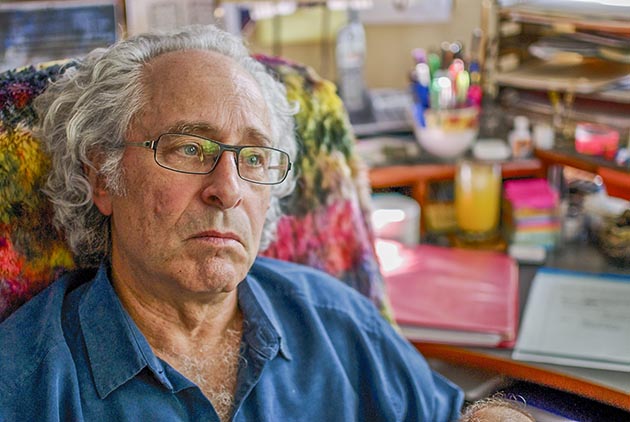
In February 2019 Susan Schaefer wrote an insightful and brilliantly written profile – “Craig Harris – A Man for All Seasons” – for the Southwest Journal in the Twin Cities, Minnesota.
This profile resurfaced, a little over a year later, as things do from time to time in social media, igniting some exciting exchanges with friends and colleagues, and providing me with a new opportunity to consider the trajectory of my work and career. I recently expanded upon some of the stories mentioned in Susan’s profile, including additional insights into several formative artistic experiences going back to my teenage years. I also have been pulling music and video from previous work out of the archives, and have been incorporating this work into the Interference Arts web site.
As the profile illustrates, my life has been enriched and informed by deep immersion in a wide variety of musical and performance genres. Early classical music piano and theory training at Eastman School of Music’s Community Education program was balanced with performing in popular music groups and specialized training in improvisation and performing from fake books. Performing in bebop and then abstract/free jazz ensembles interleaved with contemporary classical music composition studies and practice at the Faculty of Music in Toronto. Graduate studies at Eastman School of Music in the early 1980s during the rapidly evolving field of computer music provided invaluable opportunities to explore new sonic terrain and compose music using these new resources, to integrate “non-real time” computer-based music (software synthesis and processing) with highly skilled instrumental performers, and to participate in the development of that field. Several years living in the media arts haven of the Bay Area provided rare opportunities to learn, create, and collaborate with artists, instrument developers, and scientists on an international scale. Working in the dance and theater worlds of the Twin Cities brought several threads of my background together to collaborate on many creative projects and to help develop the local arts infrastructure.
Jazz Ensemble as a Teen
I formed a jazz ensemble with a group of fine young jazz performers when I was 17, including the Vitale brothers (sax, trumpet and bass) and Rich Felice (drums). This was a formative artistic period for me, as we first played bebop jazz repertoire, and then forged forward into abstract/free jazz performance. My understanding of harmonic structure and my improvisational skills evolved tremendously during this period, and my curiosity to explore new musical terrains was sparked at a new level. I continued playing free jazz through my first few years living in Toronto, while I also pursued my contemporary classical music studies.
New York Explorations
In the mid-late 1960s, still a teen living in Rochester, NY, I had several opportunities to spend time in New York City. My uncle was a long term Lower East Side resident working in the educational film industry, and his wife was the personal assistant to Leonard Bernstein. These trips were creative excursions, with a wide range of experiences that enriched and informed my artistic evolution. I went to concerts and latenight club jams where I saw and heard many of the Jazz Greats, including Miles Davis, Herbie Hancock, Oscar Peterson, Chick Corea, Dave Brubeck, Sonny Rollins, Bill Evans, Count Basie, Sun Ra, Thelonius Monk, Charlie Mingus, Ella Fitzgerald, Hazel Scott, and Elvin Jones. I attended multimedia “happenings,” the precursor to the raves of the 1990s, where I have vivid memories of multitudes of people dancing in a huge warehouse space, with loud music, and projections of transforming color shapes created by manually manipulating colored gels between transparencies.
I also had the opportunity to sit in on rehearsals and performances of the New York Philharmonic with Leonard Bernstein and Pierre Boulez conducting. One particularly poignant experience was attending a rehearsal when the orchestra was rehearsing Edgar Varese’s Intégrales. I was captivated by the work, and I was startled when Maestro Boulez stopped the orchestra and pointed out to one of the performers that the note in a particular place was supposed to be B-flat, not B-natural. I didn’t know how he would be able to know that in such a complex sound mass, and I was determined at that point to work aggressively on my ear training and score reading skills to be able to achieve that kind of musical facility. This experience took on an even more powerful significance given my evolution years later into working in computer music, and Pierre Boulez’s deep involvement in the development of that field in creating IRCAM, one of the most important computer music creation and research composition facilities in the world.
Eastman School of Music
I returned to Rochester, NY in 1980, after 9 years living in and around Toronto, to attend graduate school at Eastman School of Music. I needed to explore the potential of computer music resources to continue the development of my musical language, in a context where superb professional musicians were actively making music using traditional instruments. Significant research and innovation in computer music was taking place in the mid to late 1970s by William Buxton and others at the Dynamic Graphics Department at the University of Toronto, but there was no connection with the Faculty of Music directly across the quad. The computer music field was evolving in computer science and engineering departments in the United States as well, but Eastman was the first music conservatory in North America to develop a software synthesis-based computer music studio. In my 2nd year of the program I stepped into the role of computer music studio systems administrator, an opportunity to gain critical expertise while learning how to use the systems to create my own music. During this period I created my work Threshold, for chamber ensemble and computer-generated tape, one of the first compositions integrating live instruments with computer music to come out of the Eastman Computer Music Studio. This work premiered at the 1983 International Computer Music Conference, launching a multiyear deep engagement as a composer and developer using computer-based music resources.
Threshold (1983) is a composition for chamber ensemble and electronic soundscape, based on the following segment of text from the Lewis Carroll’s Alice in Wonderland:
Alice found herself in a long, low hall, which was lit up by a row of lamps hanging from the roof. There were doors all round the hall, but they were all locked; and when Alice had been all the way down the one side and up the other, trying every door, she walked sadly down the middle, wondering how she was ever to get out again.
Threshold had its premiere at the 1983 International Computer Music Conference. In 1986 I collaborated with Pay Byrne and Beth Gafarian to create a video version of Threshold, developed through an artist residency at the Banff Centre for the Arts and Creativity.
This recording is performed by the Minneapolis-based ensemble Zeitgeist, recorded for my multimedia production It is SHE Who I See, produced in 2012 at the Ritz Theatre.
The Bay Area Era
My artistic life evolved tremendously living in the Bay Area during a period of amazing evolution of new media arts resources (1986-1994). I was composing inDelicate Balance, a composition that incorporates sampled and transformed piano and spoken voice sources; I was working at Yamaha Music Technologies, a research facility focused on developing new computer-based music instruments and resources; I was working to advance the field, first as President of the International Computer Music Association, and then as Executive Director of the International Society of the Arts, Sciences and Technology; and I was continuing my own research and development trying to improve resources for composers working in computer music through my Configurable Space project. inDelicate Balance and Configurable Space were presented widely in international festivals, and provided a research foundation that resulted in articles published in field journals such as the Computer Music Journal, Contemporary Music Review and Leonardo, and the Proceedings of the International Computer Music Conferences. My compositional approach working with both computer-based and traditional instrumental materials evolved tremendously during this period, and I significantly advanced the foundation of tools that I continue to use and develop today in my work.
inDelicate Balance
The composition inDelicate Balance (1989) exists at the unseen, imaginary barrier, at once on all sides, and always inside and outside. It contains found sounds, live and manipulated piano sounds, and representations of sounds from the inner ear and internal world. inDelicate Balance was realized using a combination of digital software processing and mixing techniques, and real-time sampling, processing, and mixing systems.
The second movement of inDelicate Balance – “Somewhere between” – was created using sampled piano tones and gestures, and is an early example of my exploration of the “extended piano,” where I play with harmonics; incorporate different kinds of attacks, resonances and sound structures; filter, process and layer sounds; and explore alternative approaches to musical & compositional process.
Somewhere between
Somewhere between this and that
Somewhere between here and there
Somewhere between then, now, and laterThe fourth movement of inDelicate Balance is “Room Views,” a narrative soundscape that employs the same music software systems used in “Somewhere between” to offer a perspective on contemporary existence utilizing the sounds that surround us.
Room Views
Views into the present,
Views into the past,
and the future always becoming itself,
because of what it is,
what it was, and
what it has to be.
Unmemorable, unforgettable moments,
and exquisitely insignificant details,
like gentle ghosts, follow everywhere,
aching to be more than what was
left behind in the mist.Configurable Space
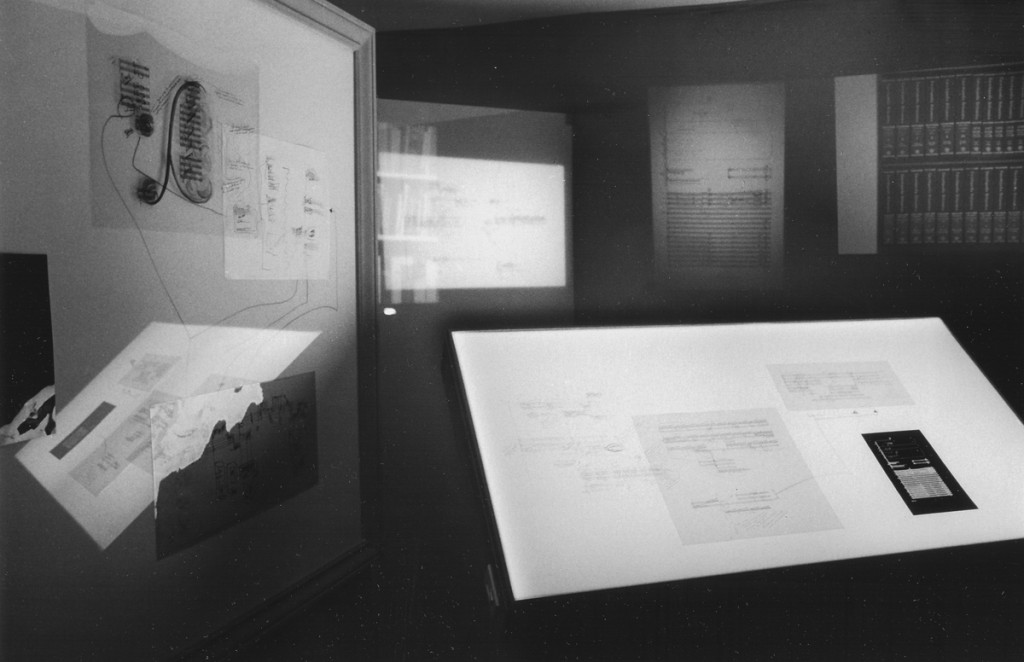
In 1987 I launched a long term research and design project entitled Configurable Space, exploring future creative work environments, the creative process and the use of new technological resources to support artistic functions. The fundamental premise hypothesizes that it is possible to develop integrated, technological resources that encompass the breadth of our beings in all of its complexity. These comprehensive resources would allow us to deepen our understanding of ourselves, and to communicate on these deeper levels in a conscious and purposeful manner.
Configurable Space is directed towards the development of a balanced understanding about how we use the visual, aural, tactile, and configurable capabilities of digital technologies, and how the tools developed affect ways that we think, feel, formulate, and develop on intellectual, spiritual, and emotional planes. It is built upon the simulation of future creative environments using any available technology that could be used to support the illusion that the implied resources already exist. The simulations incorporate representations of interactive computer display tables, walls, and holographic images, within a multi-dimensional sound environment. This creates the context for exploring relevant issues and for imagining how the space might be used in actual circumstances. The simulations represent ongoing research and artistic explorations, probing the creative process, and the relationship between artists and new technologies. In Configurable Space the artist dynamically constructs the total environment and the creative tools to suit specific requirements.
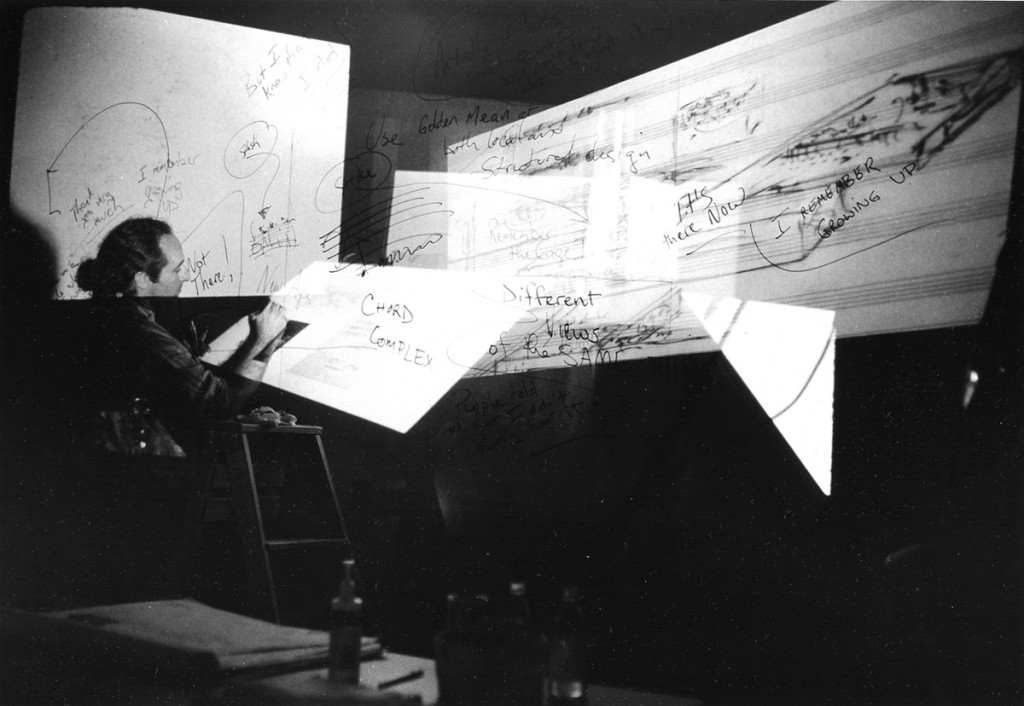
Configurable Space VII was a hybrid performance-presentation sponsored in 1990 by Yamaha Music Technologies in Marin, California, a long term research and development facility working towards creating new computer-based music instruments and music resources. The purpose of the event was to demonstrate the underlying concepts of Configurable Space in a context permitting experimentation with multimedia communication resources – at times performative, while at other times presentational; sometimes didactic, and sometimes sensational.
The event space, appropriately located in an office presentation space intended for corporate communication, was built around a large, white wall. Multiple slide projectors were positioned carefully with respect to image size, angle, and proximity. A multi-layered sound environment included original music, prerecorded music from different cultures and styles, and prepared soundfiles of sampled and processed sound, all placed in a variety of simulated room environments.
Collaboration with Renée Fleming
Soprano Renée Fleming and I collaborated to bring the diverse worlds of the art song and computer music together. Grants from the Jerome Foundation and the Hanson Institute for American Music supported my composition The Hill has Something to Say, which premiered in Alice Tully Hall, Lincoln Center. Renée triggered soundtracks based on blown and transformed blown bottle tones from the stage on a laptop computer. This was a rare opportunity for me to have my work presented in that community.
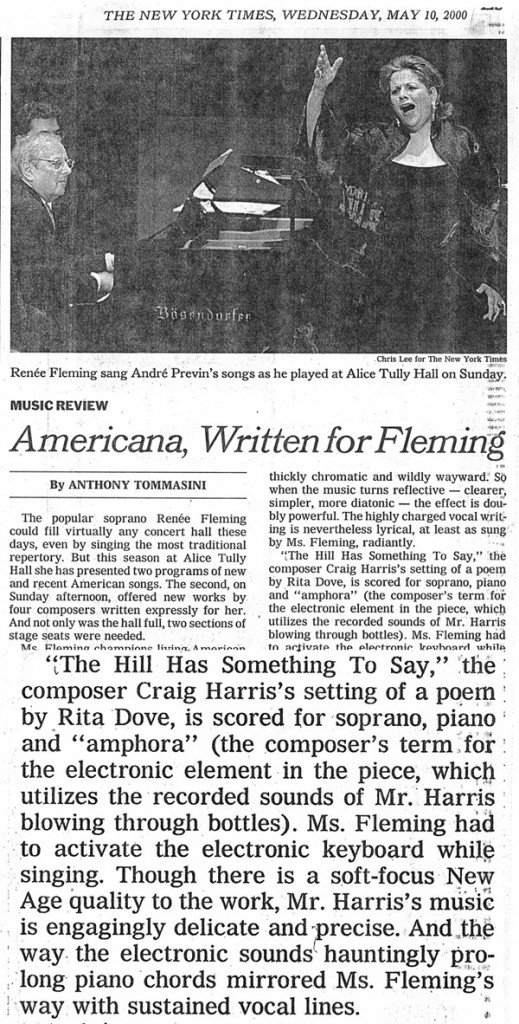
Here is an audio recording of Soprano Norah Long singing The Hill has Something to Say, with me performing on piano. This recording was developed for my multimedia performance work It is SHE Who I See (2012) at the Ritz Theatre in Minneapolis.
The Red Shoes & the Ritz Theater
In the Twin Cities I collaborated to create and produce many dance theatre shows, and was involved in creative facilities development. As Executive Director of the dance theatre company Ballet of the Dolls, I was leading an initiative to transform the Ritz Theater, a dilapidated 900-seat theater, into a multi-use performing arts venue. During that time I collaborated with Artistic Director and Choreographer Myron Johnson to create two full length ballets, and several other works for performances and events. My ballet The Red Shoes opened in 2001 one week after 9-11 in the raw Ritz theater. We brought in generators and staging, laid tarps over dirty old seating, and performed while rain was leaking into the building. It was magical and eerie, and became a landmark event in the community.
We mounted an updated version of The Red Shoes at Theatre de la Jeune Lune in Minneapolis in 2002. In this scene from the performance – “Trio Triage” – we are backstage following the successful premiere performance of the ballet company’s new production, The Red Shoes Fairy Tale Ballet, where prima ballerina Victoria Paige performed the lead role to music composed by her lover, Julian Craster, the composer of the music score. As illustrated in the scene, the tension Vicky experiences is caused by company Director Boris Lermontov urging her to forego love to pursue her career, while Julian is also pressuring her to give up her passion for dance and go away with him. A tightening vice between both sides of her world in the end becomes intolerable.
The Ritz Theater
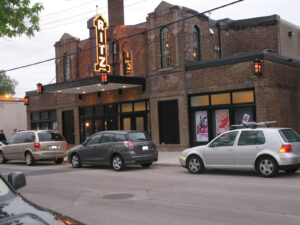
The Ritz Theater was a 900-seat movie theater that had been closed since 1982, and was in a state of deterioration, adding to neighborhood blight and crime, and inhibiting community development. I helped to build the dance company’s infrastructure and capacity, created strong relationships within the neighborhood and with government officials, helped to raise $2.2 million, managed the renovation of the theater, and launched the theater’s first season with a variety of dance, theater and music activity.
The renovated Ritz Theater opened in 2006, with a beautiful and well-equipped 240-seat theater, a large studio and event space, a lobby with concession area, and office space.
Today the 13th Avenue NE strip is completely transformed with the arts as a central feature in the district, thriving with successful restaurants and shops, and ongoing performance activity at the theater attracting thousands of people to the neighborhood each year. Award-winning Twin Cities musical theater company Theater Latté Da currently owns and operates the Ritz Theatre.
SHAPE Ensemble
In 2011 I formed an experimental improvisation ensemble comprised of Viv Corringham (vocalist), Stephen Goldstein (laptops and various electronics and controllers) and me (real time sampling and processing).
Viv extemporizes with a broad vocal palette, with and without words; Stephen draws upon his vast toolbox of sounds, controllers and live performance techniques; and I record and process them both, feeding the material back into the mix to create a sound fabric that we “shape” together. It was a remarkable opportunity to co-create adventurous music with such talented artists.
In 2012 I revisited Rita Dove’s poem The Hill has Something to Say, and with Shape created On the Hill, an improvisational deconstruction of the poem, representing an increasingly fragmenting global situation. The excerpt below was performed at my multimedia performance work It is SHE Who I See.
Learn more about Shape on this page of the Interference Arts website.
It is SHE Who I See

In 2012 I created and produced It is SHE Who I See, a multimedia production built upon a foundation of my through composed compositions performed live and recorded, and incorporating improvisational performances with the SHAPE ensemble. It is She Who I See celebrates the universal woman who is in all of us, and explores the tension between male and female energy in the world and within us.
With this production I significantly advanced my multimedia theatrical aesthetic and flexibility. The show included live music performance, a multi-dimensional soundspace, a multi-projector visual design displayed on a stage hung with translucent scrims, lighting design, and movement.
I had the opportunity to work with an amazing group of artistic collaborators on this production, many of whom I continue to work on projects to this day.
It is SHE Who I See included a video of soprano Norah Long singing “The Hill has Something to Say,” heard in the music example above; the SHAPE ensemble performing “On the Hill,” heard above; “Threshold,” performed by the Zeitgeist ensemble, heard above, with live movement performance by Paul Herwig; and a live performance of the piano-cello suite SHE, performed by Randall Davidson on cello, with me on piano.
Two months before the performance in November 2012 we held a “seeding” event, a multi-day rehearsal and recording session where we tested out many of the production concepts for the show, recorded material for the audio and video components of the show, and held a special audience participation activity where people in attendance had an opportunity to put on wearable art, walk onto the stage to experience the multi-dimensional space, and to engage in a gestural exploration of the concept of Beauty, guided by our project midwife Kym Longhi. This material was used as source material for the show, integrated into a scene entitled “Beauty Is,” which was accompanied by a recording of my music composed for Ballet of the Dolls’ dance theatre production Sleeping Beauty. We also held a special recording session for the artists involved in the production where we all shared thoughts about who SHE is, with that material integrated into a sonic soundscape that closed the show.
Learn more about It is SHE Who I See in this area of the Interference Arts website.
Why We Laugh: A Terezín Cabaret

I was a composer, arranger and Music Director in a collaboration that revived a cabaret written and performed by prisoners in the WWI Terezin Prison Camp, in a context exploring theater and humor during the Holocaust. Kira Obolensky wrote the play Why We Laugh: A Terezín Cabaret, incorporating elements from the original cabaret by Felix Porges, Vítězslav Horpatzky, Pavel Weisskopf and Pavel Stránský. Hayley Finn was the director; Lisa Peschel found the original manuscript, and served as translator and dramaturg.
I wrote some of the music for the show, and I drew upon my experience performing from fake books to create realizations of song remnants that surfaced along with the script. This was a powerful artistic experience that included local performances, a tour to Terezin and Prague, a documentary film score, and a performance-presentation version of the work in Madison, WI. This was a powerful experience given my Jewish cultural heritage, having family members lost during the Holocaust and Eastern European pogroms, and a daughter married to a Palestinian born and raised in a West Bank refugee camp.
Richard Krevolin created the documentary film about this project – “Making Light in Terezin.”
For more details about Why We Laugh please visit this page on the Interference Arts website.
Dancing on the Belly of the Beast
I collaborated with dance theatre company Off-Leash Area to create Dancing on the Belly of the Beast, a show exploring the theme of adult orphanhood. My mother had recently passed away, and my father had passed a few years earlier. I performed through-composed music created for this show; and I captured stories from the performers, integrating that material into soundscapes for the show. It was an extremely moving experience.
As Off-Leash Area’s Co-Artistic Director Jennifer Ilse describes Dancing on the Belly of the Beast, “the show explores the universality of grief and death, and specifically the intense transition into this life stage which we all expect to reach when all of our parents have gone.”
This scene presents excerpts from some movements from a scene we called the “Emotion Gallery,” a series of reflections on some of the emotions that accompany the experience.